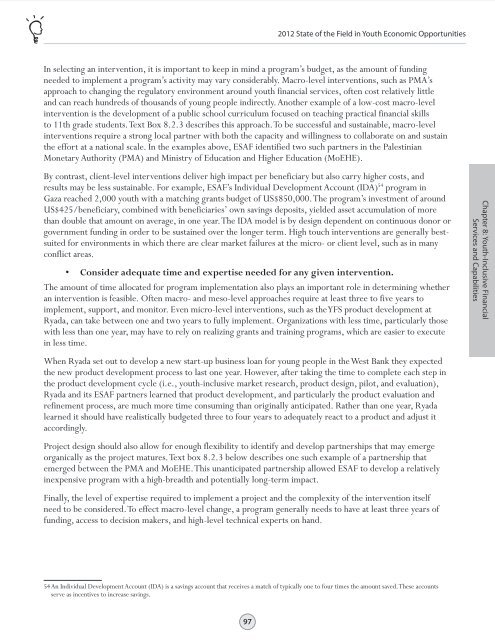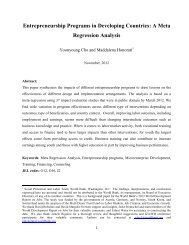STATE OF THE FIELD IN YOUTH ECONOMIC OPPORTUNITIES
STATE OF THE FIELD IN YOUTH ECONOMIC OPPORTUNITIES
STATE OF THE FIELD IN YOUTH ECONOMIC OPPORTUNITIES
You also want an ePaper? Increase the reach of your titles
YUMPU automatically turns print PDFs into web optimized ePapers that Google loves.
Table of Contents<br />
Chapter 9<br />
Chapter 1 Chapter 2 Chapter 3 Chapter 4 Chapter 5 Chapter 6 Chapter 7 Chapter 8<br />
Chapter 10 Chapter 11 Chapter 12 Chapter 13 Chapter 14 Chapter 15 Annexes<br />
2012 State of the Field in Youth Economic Opportunities<br />
In selecting an intervention, it is important to keep in mind a program’s budget, as the amount of funding<br />
needed to implement a program’s activity may vary considerably. Macro-level interventions, such as PMA’s<br />
approach to changing the regulatory environment around youth financial services, often cost relatively little<br />
and can reach hundreds of thousands of young people indirectly. Another example of a low-cost macro-level<br />
intervention is the development of a public school curriculum focused on teaching practical financial skills<br />
to 11th grade students. Text Box 8.2.3 describes this approach. To be successful and sustainable, macro-level<br />
interventions require a strong local partner with both the capacity and willingness to collaborate on and sustain<br />
the effort at a national scale. In the examples above, ESAF identified two such partners in the Palestinian<br />
Monetary Authority (PMA) and Ministry of Education and Higher Education (MoEHE).<br />
By contrast, client-level interventions deliver high impact per beneficiary but also carry higher costs, and<br />
results may be less sustainable. For example, ESAF’s Individual Development Account (IDA) 54 program in<br />
Gaza reached 2,000 youth with a matching grants budget of US$850,000. The program’s investment of around<br />
US$425/beneficiary, combined with beneficiaries’ own savings deposits, yielded asset accumulation of more<br />
than double that amount on average, in one year. The IDA model is by design dependent on continuous donor or<br />
government funding in order to be sustained over the longer term. High touch interventions are generally bestsuited<br />
for environments in which there are clear market failures at the micro- or client level, such as in many<br />
conflict areas.<br />
• Consider adequate time and expertise needed for any given intervention.<br />
The amount of time allocated for program implementation also plays an important role in determining whether<br />
an intervention is feasible. Often macro- and meso-level approaches require at least three to five years to<br />
implement, support, and monitor. Even micro-level interventions, such as the YFS product development at<br />
Ryada, can take between one and two years to fully implement. Organizations with less time, particularly those<br />
with less than one year, may have to rely on realizing grants and training programs, which are easier to execute<br />
in less time.<br />
Chapter 8: Youth-Inclusive Financial<br />
Services and Capabilities<br />
When Ryada set out to develop a new start-up business loan for young people in the West Bank they expected<br />
the new product development process to last one year. However, after taking the time to complete each step in<br />
the product development cycle (i.e., youth-inclusive market research, product design, pilot, and evaluation),<br />
Ryada and its ESAF partners learned that product development, and particularly the product evaluation and<br />
refinement process, are much more time consuming than originally anticipated. Rather than one year, Ryada<br />
learned it should have realistically budgeted three to four years to adequately react to a product and adjust it<br />
accordingly.<br />
Project design should also allow for enough flexibility to identify and develop partnerships that may emerge<br />
organically as the project matures. Text box 8.2.3 below describes one such example of a partnership that<br />
emerged between the PMA and MoEHE. This unanticipated partnership allowed ESAF to develop a relatively<br />
inexpensive program with a high-breadth and potentially long-term impact.<br />
Finally, the level of expertise required to implement a project and the complexity of the intervention itself<br />
need to be considered. To effect macro-level change, a program generally needs to have at least three years of<br />
funding, access to decision makers, and high-level technical experts on hand.<br />
54 An Individual Development Account (IDA) is a savings account that receives a match of typically one to four times the amount saved. These accounts<br />
serve as incentives to increase savings.<br />
97

















